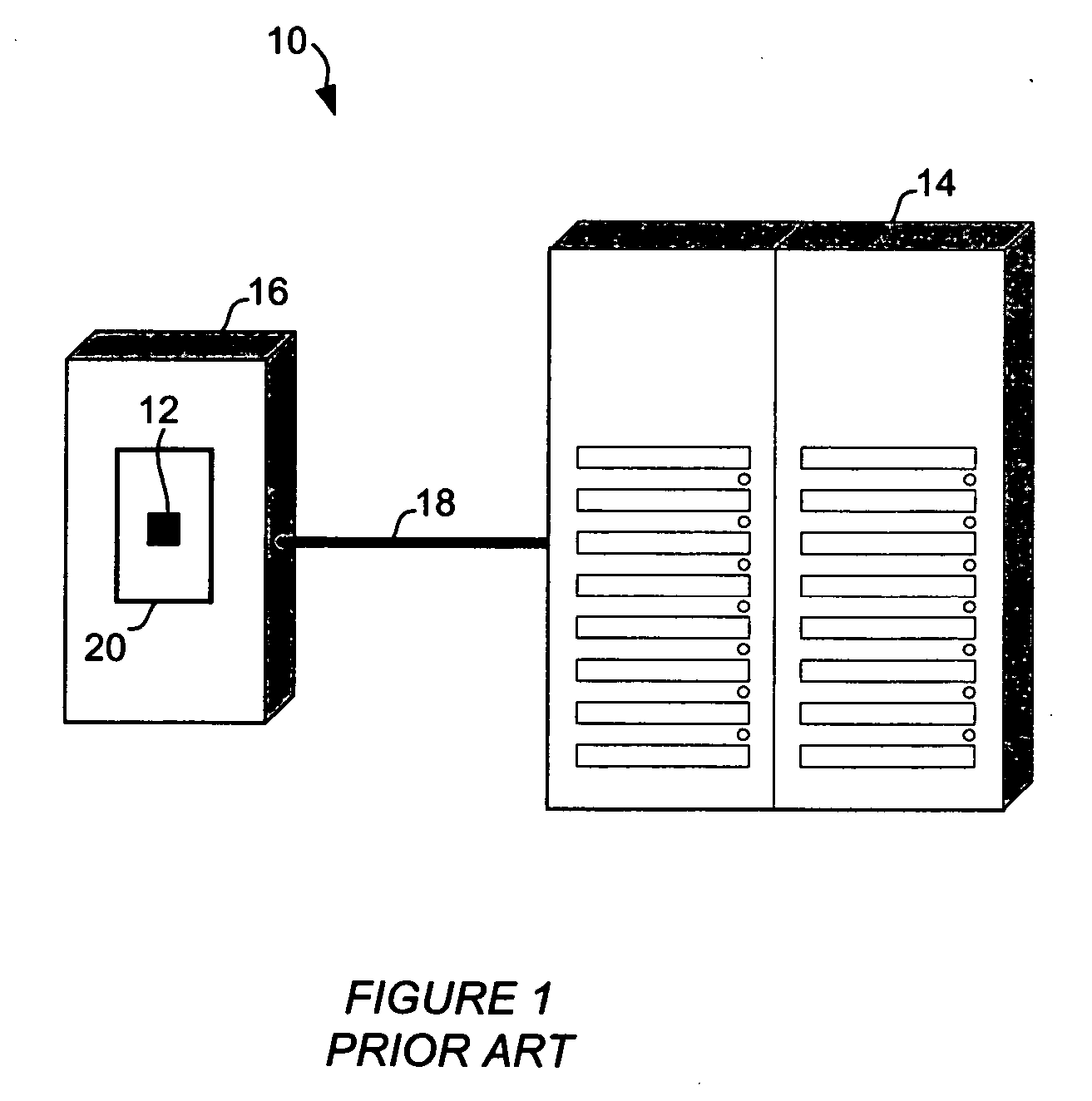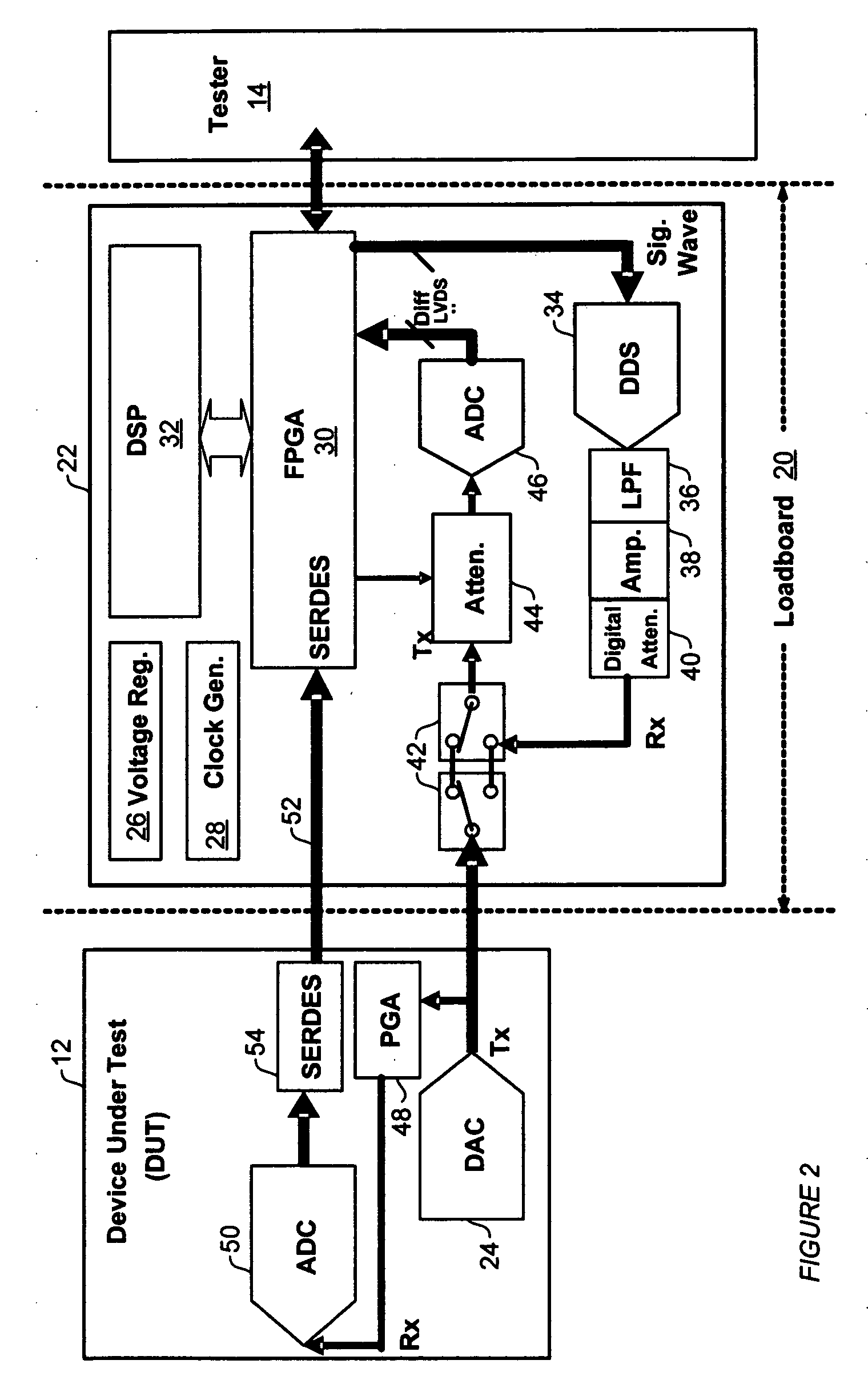[0012] In the present invention, a tester connects to a test interface board, called a “load board, that is attached to a test head. One side of the load board has a socket that receives an
integrated circuit chip for analog testing. The opposite side of the board contains all the electrical connections, circuitry, chips, and processors needed for performing the test on the
chip. The improvement to this
system comprises additional electronic circuitry that is designed into or attached to the load board that performs the tasks of a test formerly performed by a tester 14. The circuitry is organized on a board called an analog BIST (Built-in
Self Test) module. On the test module, analog circuits are attached to the load board that perform most, or all, of the testing tasks. The analog tests can be performed by one or more test boards on a load board in parallel for one or multiple devices under test (DUTs), resulting in faster testing than a conventional tester.
[0013] If a tester can perform one analog test, one device at a time and each test takes one second, about 100 seconds are required for testing one hundred analog cells in a single DUT. But on the load board, with specific circuitry of a test module to test one hundred analog circuits in parallel, the entire test takes one second, significantly increasing efficiency of device testing and reducing costs. In production of an integrated circuits, millions of chips may be produced and tested. The savings of millions of seconds of test time provided by the present invention also reduces the costs an equivalent amount.
[0014] Conventional testers are very expensive and cannot be purchased often to keep up with the fastest
computer technology. Most testers have built-in limitations of speed and performance to test devices. For example, if input bandwidth of the analog measurement unit on the tester is limited to 100 MHz, the test module of the present invention can be built to a specified input bandwidth of 500 MHz or 1 GHz. It is much easier and cost effective to replace a component of a load board in order to increase
processing speed and capacity of a test system instead of either putting an expensive production run on hold or to buy a completely new test system.
[0016] To increase flexibility of component specifications and testing capacity, the exemplary analog BIST module of the present invention is preferably an add-on component to a load board, however the load board itself could have the components and functionality of a test module built-into the board. Components of a test module include an FPGA (
Field Programmable Gate Array).
Test setup is performed by the FPGA. A DAC or DDS is used to drive any analog input of the DUT and an
amplifier may be added in the
stream with a digital attenuator to adjust the test
signal amplitude.
Test data inside the DUT that is converted to digital by an ADC (Analog-to-
Digital Converter) is exported through an optional
SERDES (serialize / deserialize) port. The FPGA captures the test data from the
SERDES into memory or a buffer and drives the data to an on-board DSP for analysis. An ADC with a
high input band-width samples or under-samples any analog output from the DUT prior to export in digital format to the FPGA. The
processing and speed for analyzing the captured data may be adjusted by choosing the appropriate number of DSPs for the volume and type of tests being performed on multiple DUTS in a tester. Relays are also included in the test module to enable self-test of the BIST prior to starting device tests and to apply / measure Analog differential signals to / from the DUT.
[0017] The various embodiments of an analog BIST module enable extremely fast analog final test and analog characterization of a DUT on any tester, such as a VLCT.
Test setup can be performed simpler and faster by DFT (Design for Test) techniques so that every test mode will set a value into all relevant registers inside the DUT without the need for
programming by functional vectors. The module enables parallel, simultaneous tests of all analog ports or differential channels of the DUT. The
jitter in the
clock distribution on the module is reduced by using OCXO and LVPECL devices and level translators for every
clock receiver. Data stimuli and capture is performed faster by using high-speed digital interfaces such as
SERDES and LVDS, and ADC or DAC / DDS components with appropriate speed specifications.
Data analysis is performed quicker by using one or more DSPs on the module without functional patterns for transferring the captured data to the tester. Various implementations of the analog BIST module in a test system include directly attached to a load board, connected to a load board through an appropriate data
bus.
 Login to View More
Login to View More  Login to View More
Login to View More 


